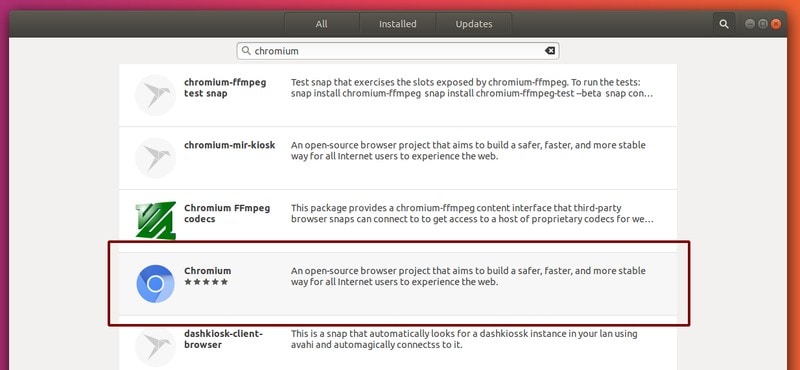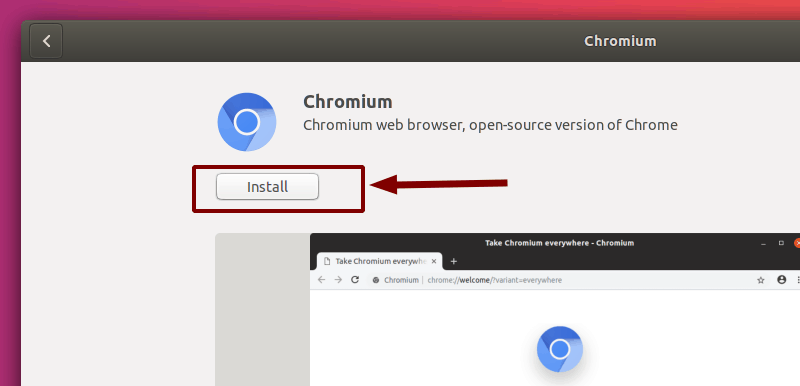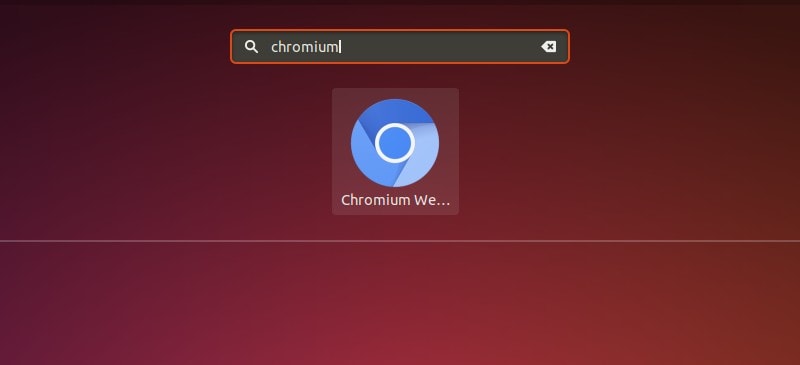- Linux Quick Start
- Download / Build the Browser
- Set Up Policies
- Push out the Policies and Browser
- Download Chromium
- Chrome for Testing
- Chromium
- Easy Point and Click for latest build:
- Easy Script to download and run latest Linux build:
- Not-as-easy steps:
- Please file bugs as appropriate.
- Downloading old builds of Chrome / Chromium
- How to Install Chromium Browser in Ubuntu Linux
- Installing Chromium in Ubuntu
- Installing Chromium Beta & Dev Channels
- Install Chromium Beta channel in Ubuntu
- Install Chromium Dev channel in Ubuntu
- Install Chromium via Flathub
Linux Quick Start
This page describes the steps to get a managed instance of Google Chrome or Chromium up and running on Linux.
Download / Build the Browser
- If you want to deploy Google Chrome, download Google Chrome here.
- If you want to deploy Chromium, your distro may have already repackaged Chromium for you. See which distros have repackaged Chromium here.
- If you want to deploy Chromium but you want to build it yourself, follow the instructions on building Chromium here.
At the end of this process, you should have Google Chrome or Chromium installed.
Set Up Policies
The location of the policy configuration files depends on whether you are running Google Chrome or Chromium:
- Google Chrome looks for policies installed in /etc/opt/chrome/policies
- Chromium looks for policies installed in /etc/chromium/policies by default
- Note: if you use a Chromium package from a Linux distribution, please make sure you check its documentation. Ubuntu’s package checks for policies in /etc/chromium-browser/policies instead, for example.
There are two sets of policies kept in these directories: one set that is required and mandated by an administrator, and one set that is recommended for users but not required. For Google Chrome, these two sets live at (remember that the paths differ for Chromium):
Create these directories if they do not already exist:
mkdir /etc/opt/chrome/policies mkdir /etc/opt/chrome/policies/managed mkdir /etc/opt/chrome/policies/recommendedMake sure that the files under /managed are not writable by non-admin users; otherwise, they could just overwrite your policies to get the configuration they want!
chmod -w /etc/opt/chrome/policies/managedTo set policies that are required, create a file named «test_policy.json» in /etc/opt/chrome/policies/managed/
touch /etc/opt/chrome/policies/managed/test_policy.jsonIn this file, put the following content:
That’s it! The next time you start Google Chrome on that machine, the home button next to the location bar (which is not shown by default) will be shown and locked to this value.
To see what other policies you can control, review the exhaustive list of all manageable policies.
You can spread your policies over multiple JSON files. Chrome will read and apply them all. However, you should not be setting the same policy in more than one file. If you do, it is undefined which of the values you specified prevails.
Make sure that policy JSON files under ../managed/ are not writable by just anyone! Google Chrome / Chromium gives these files higher priority, so they should only be writable by an administrator or root!
Push out the Policies and Browser
Using whatever mechanism you use to push files to clients, whether it be a utility or just a script file, push the «test_policy.json» file out to the target machines in your network. Make sure that this file exists at /etc/opt/chrome/policies/managed/ on all the target machines. You could do this simply by scp’ing the files to the target:
scp -r /etc/opt/chrome/policies adminusername@targetmachine:/etc/opt/chromeSimilarly, use whatever file-pushing utility or script to push out Google Chrome / Chromium. Whenever a user on those target machines runs Google Chrome / Chromium, it will obey the policy files you copied onto those machines.
Download Chromium
You can test Chrome builds or Chromium builds. Chrome builds have the most infrastructure for analyzing crashes and reporting bugs. They also auto-update as new releases occur, which makes them a good choice for most uses. Chrome Canary is available for Windows and Mac and autoupdates daily. Other channels (Dev and Beta) are available. Chrome for Testing builds and Chromium builds do not auto-update, and do not have symbols. This makes them most useful for checking whether a claimed fix actually works. Use the following instructions to find builds.
Chrome for Testing
Chrome for Testing is a dedicated flavor of Chrome targeting the testing use case, without auto-update, integrated into the Chrome release process, made available for every Chrome release across all channels (Stable/Beta/Dev/Canary). The easiest way to download Chrome for Testing binaries for your platform is by using the @puppeteer/browsers command-line utility, available via npm . Here are some examples:
# Download the latest available Chrome for Testing binary corresponding to the Stable channel. npx @puppeteer/browsers install chrome@stable # Download a specific Chrome for Testing version. npx @puppeteer/browsers install chrome@116.0.5793.0 # Download the latest available ChromeDriver version corresponding to the Canary channel. npx @puppeteer/browsers install chromedriver@canary # Download a specific ChromeDriver version. npx @puppeteer/browsers install chromedriver@116.0.5793.0If you prefer to build your own automated scripts for downloading these binaries, refer to the JSON API endpoints with the latest available versions per Chrome release channel (Stable, Beta, Dev, Canary). To get a quick overview of the latest status, consult the Chrome for Testing availability dashboard.
Chromium
In contrast to Chrome for Testing builds, Chromium builds are made available on a best-effort basis, and are built from arbitrary revisions that don’t necessarily map to user-facing Chrome releases.
Easy Point and Click for latest build:
Easy Script to download and run latest Linux build:
Not-as-easy steps:
- Head to https://commondatastorage.googleapis.com/chromium-browser-snapshots/index.html
- Choose your platform: Mac, Win, Linux, ChromiumOS
- Pick the Chromium build number you’d like to use
- The latest one is mentioned in the LAST_CHANGE file
Please file bugs as appropriate.
Downloading old builds of Chrome / Chromium
Let’s say you want a build of Chrome 44 for debugging purposes. Google does not offer old builds as they do not have up-to-date security fixes.
However, you can get a build of Chromium 44.x which should mostly match the stable release.
- Look in https://googlechromereleases.blogspot.com/search/label/Stable updates for the last time «44.» was mentioned.
- Loop up that version history («44.0.2403.157») in the Position Lookup
- In this case it returns a base position of «330231». This is the commit of where the 44 release was branched, back in May 2015.*
- Open the continuous builds archive
- Click through on your platform (Linux/Mac/Win)
- Paste «330231» into the filter field at the top and wait for all the results to XHR in.
- Eventually I get a perfect hit: https://commondatastorage.googleapis.com/chromium-browser-snapshots/index.html?prefix=Mac/330231/
- Sometimes you may have to decrement the commit number until you find one.
* As this build was made at 44 branch point, it does not have any commits merged in while in beta.
Typically that’s OK, but if you need a true build of «44.0.2403.x» then you’ll need to build Chromium from the 2403 branch. Some PortableApps/PortableChromium sites offer binaries like this, due to security concerns, the Chrome team does not recommend running them.
How to Install Chromium Browser in Ubuntu Linux
Chromium is an open-source browser project that sits at the foundation of Google Chrome. It is maintained by The Chromium Projects, along with Chromium OS.
You can install Google Chrome in Ubuntu easily but if you want to use the open source version of Chrome (i.e. Chromium), then you are at the right place.
In this article, I’ll be covering information about Chromium, how you can install Chromium in Ubuntu and other Linux distributions, as well as how to install the Beta and Dev versions of Chromium.
Installing Chromium in Ubuntu
There are various ways you can install Chromium on your Linux machine.
If you are okay with using commands, you can simply type this in the terminal:
sudo apt install -y chromium-browser
If you are not comfortable with terminal, don’t worry. In Ubuntu (as well as in other distributions), you can find Chromium in the Software Center. Open up Software Center and search for Chromium:
Click on the entry and then on Install:
You can now open Chromium by searching for it in the Applications menu:
or by opening up a terminal and typing in:
You can uninstall the app in Ubuntu the same way you installed it (from the Software Center).
However, you may not get the latest version through the software center, if you want that, you can follow any of the methods below.
You can use install the snap version of Chromium on any distribution using:
sudo snap install chromiumYou can uninstall this version with:
sudo snap remove chromiumIf you installed Chromium using the package manager (or the PPA), you can install/update the non-proprietary media codecs using:
sudo apt install -y chromium-codecs-ffmpegIf you want to add the proprietary media codecs:
sudo apt install -y chromium-codecs-ffmpeg-extraAdditionally, on Arch, you can install chromium-widevine from the user repositories. This will allow you to stream Netflix in Linux, for example.
Installing Chromium Beta & Dev Channels
Dev and Beta builds of Chromium enable you to access several experimental features that are not available in the stable version. Some enthusiastic users or developers try these unstable channels from time to time.
You can install the beta and dev version of Chromium using an unofficial PPA.
Note: Your install of stable Chromium browser will be overridden by the unstable version.
Install Chromium Beta channel in Ubuntu
Use the following commands to install Chromium Beta:
sudo add-apt-repository ppa:saiarcot895/chromium-beta sudo apt-get update sudo apt-get install chromium-browser
To remove this (unstable) version, use:
sudo apt remove -y chromium* sudo ppa-purge ppa:saiarcot895/chromium-beta
Install Chromium Dev channel in Ubuntu
Enter the following in the terminal to install Chromium Dev:
sudo add-apt-repository ppa:saiarcot895/chromium-dev sudo apt-get update sudo apt-get install chromium-browser
As before, to remove this unstable version, use:
sudo apt remove -y chromium* sudo ppa-purge ppa:saiarcot895/chromium-dev
Install Chromium via Flathub
If you need the latest stable version and you prefer using Flatpak, you can choose to install the Flatpak package.
Chromium is available as a Flatpak package on Flathub but the only problem is — you need to have Flatpak 1.8.2 installed to be able to install Chromium.
You can check your installed version by typing in:
If you have anything below 1.8.2, you need to upgrade Flatpak installed on your system. You can easily do that using the following commands below:
Note: This will upgrade your Flatpak to the latest pre-release version (proceed at your own risk):
sudo add-apt-repository ppa:alexlarsson/flatpak sudo apt update sudo apt upgradeOnce you’re done upgrading, you can simply install Chromium using the command:
flatpak install flathub org.chromium.ChromiumWrapping Up
In this article, I’ve covered some features of Chromium and the various methods you can install it on Ubuntu and other Linux distributions, even covering Beta and Dev releases.
I also recommend mastering Chromium keyboard shortcuts to use it more efficiently.
Thanks for reading our article. We hoped that you learned something new while reading it. As always, we are eager to hear your questions and suggestions in the comments!


